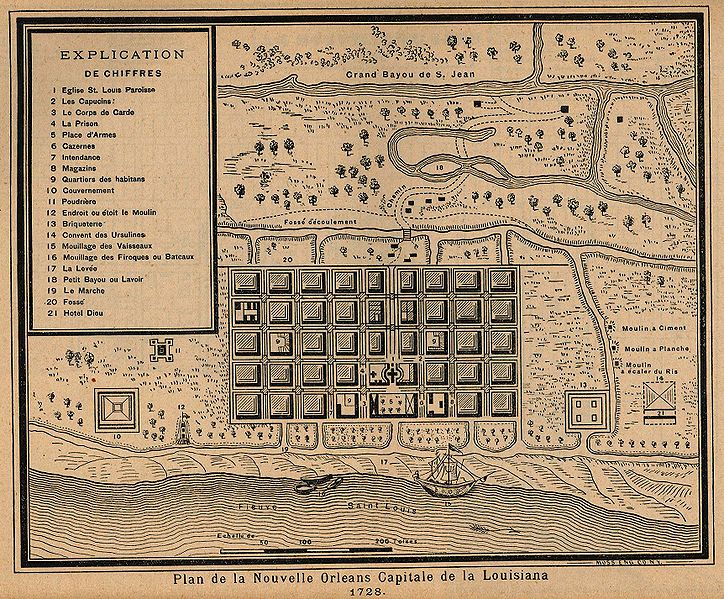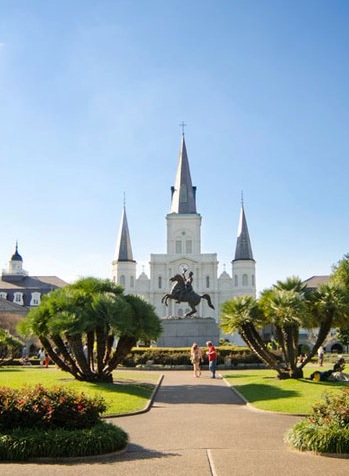Need a primer on New Orleans’ long and storied past? Experience New Orleans offers a two-part snapshot of what happened where in New Orleans, from the city’s founding to the present-day. Whether you’re a NOLA native or new visitor, we bet you’ll learn something!
 Starting Out
Starting Out
The Gulf South was first inhabited by Native Americans, starting as early as 1000 B.C.E. This would be a pretty long history if we started there, though, so let’s fast-forward a bit! By the 1690s, fur trappers and traders had reached the region. In 1718, French explorers led by Jean-Baptiste Le Sieur de Bienville founded the colony of “La Nouvelle Orleans” in honor of Philip II, Duke of Orleans and then-Regent of France.
 Life in the colony was tough, as New Orleans’ climate fostered disease and disaster, but colonists persevered. In 1722, after a hurricane flattened much of the colony, assistant city engineer Adrien de Pauger drew up plans for the 7-by-11-block rectangle that would become known as the “Vieux Carré,” or “Old Square.” This is where you can find a melange of New Orleans culture and architecture; a street is named in Pauger’s honor in what is now the Marigny area.
Life in the colony was tough, as New Orleans’ climate fostered disease and disaster, but colonists persevered. In 1722, after a hurricane flattened much of the colony, assistant city engineer Adrien de Pauger drew up plans for the 7-by-11-block rectangle that would become known as the “Vieux Carré,” or “Old Square.” This is where you can find a melange of New Orleans culture and architecture; a street is named in Pauger’s honor in what is now the Marigny area.
French, then Spanish, then back to French
When Britain won the Seven Years’ War in 1763, Spain was given the land west of the Mississippi. As you can imagine, New Orleans’ mostly French population was not excited to suddenly be Spanish, and conflict broke out– however, New Orleans remained under Spanish control for 39 years. During this short time, the Spanish were instrumental in making New Orleans the thriving port city it still is today. And after the Great Fire of 1788, much of the Vieux Carre was rebuilt in “second-generation Creole” and Greek Revival styles, with European courtyards that offered seclusion and privacy. “Madame John’s Legacy,” at 632 Dumaine Street, which survived the fire, is one of the few remaining examples of traditional French colonial architecture in the Quarter.
however, New Orleans remained under Spanish control for 39 years. During this short time, the Spanish were instrumental in making New Orleans the thriving port city it still is today. And after the Great Fire of 1788, much of the Vieux Carre was rebuilt in “second-generation Creole” and Greek Revival styles, with European courtyards that offered seclusion and privacy. “Madame John’s Legacy,” at 632 Dumaine Street, which survived the fire, is one of the few remaining examples of traditional French colonial architecture in the Quarter.
In 1800, control of New Orleans returned to France–but just for three years, because in 1803, Napoleon sold the entire Louisiana territory to the United States for the tidy sum of $15 million (about $233 million today: still a miniscule price for almost 900,000 square miles of land!).
 American Rule and Civil War
American Rule and Civil War
Just one year after the Louisiana Purchase, the Haitian Revolution brought an influx of French-speaking immigrants to New Orleans, followed by another wave of immigrants from St. Domingue in 1809-1810. With French, Spanish, Creole, Acadian, African and now Haitian and Dominguan settlers, the city started to become a cosmopolitan destination, while remaining notorious for its wildness and frontier-like feel. By 1810, New Orleans was the largest city in the south, and the fifth-largest in the United States.
Louisiana became a state in 1812, and when America went to war against Britain just a few months later, General Andrew Jackson led an unconventional defense force to victory in the famous Battle of New Orleans. See a statue of Jackson at Jackson Square!
Despite victory against the Brits, New Orleans wasn’t as lucky when Union soldiers came a-knocking during the “War Between the States.” Luckily, the city was spared the destruction that usually came with a Union occupation–otherwise, there wouldn’t be much to see!
Turn of the Century
By 1900, things were changing in New Orleans: French instruction in schools was fading, the city was fast industrializing, and the Creole elite were losing their prominence as New Orleans neighborhoods diversified with immigrants of all origins. More hardships were in store, including an outbreak of yellow fever in 1905–the final epidemic of the disease in the United States–that killed more than 40,000 residents.
Though much-anticipated, the 1884 World's Fair, or Cotton Centennial, in New Orleans, was mostly a failure. It opened two weeks behind schedule, and despite attractions like a Horticultural Hall with plants from all over the world, and a display of 5,000 electric lights. The site is now Audubon Park and Zoo.
But it wasn’t all bad. In the early 1900s, inventor A. Baldwin Wood created the screw pump, a powerful and ingenious mechanization that allowed New Orleans to develop much of the “back swamp” that surrounded the city. We still use the screw pump and its subsequent incarnations to drain low areas of New Orleans today!
Is your head spinning yet? Stick around for the second NOLA History Lesson next week!



